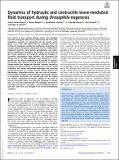| dc.contributor.author | Imran Alsous, Jasmin | |
| dc.contributor.author | Romeo, Nicolas | |
| dc.contributor.author | Jackson, Jonathan A | |
| dc.contributor.author | Mason, Frank M | |
| dc.contributor.author | Dunkel, Jörn | |
| dc.contributor.author | Martin, Adam C | |
| dc.date.accessioned | 2021-10-27T20:04:38Z | |
| dc.date.available | 2021-10-27T20:04:38Z | |
| dc.date.issued | 2021 | |
| dc.identifier.uri | https://hdl.handle.net/1721.1/134366 | |
| dc.description.abstract | © 2021 National Academy of Sciences. All rights reserved. From insects to mice, oocytes develop within cysts alongside nurse-like sister germ cells. Prior to fertilization, the nurse cells’ cytoplasmic contents are transported into the oocyte, which grows as its sister cells regress and die. Although critical for fertility, the biological and physical mechanisms underlying this transport process are poorly understood. Here, we combined live imaging of germline cysts, genetic perturbations, and mathematical modeling to investigate the dynamics and mechanisms that enable directional and complete cytoplasmic transport in Drosophila melanogaster egg chambers. We discovered that during “nurse cell (NC) dumping” most cytoplasm is transported into the oocyte independently of changes in myosin-II contractility, with dynamics instead explained by an effective Young–Laplace law, suggesting hydraulic transport induced by baseline cell-surface tension. A minimal flow-network model inspired by the famous two-balloon experiment and motivated by genetic analysis of a myosin mutant correctly predicts the directionality, intercellular pattern, and time scale of transport. Long thought to trigger transport through “squeezing,” changes in actomyosin contractility are required only once NC volume has become comparable to nuclear volume, in the form of surface contractile waves that drive NC dumping to completion. Our work thus demonstrates how biological and physical mechanisms cooperate to enable a critical developmental process that, until now, was thought to be mainly biochemically regulated. | |
| dc.language.iso | en | |
| dc.publisher | Proceedings of the National Academy of Sciences | |
| dc.relation.isversionof | 10.1073/pnas.2019749118 | |
| dc.rights | Article is made available in accordance with the publisher's policy and may be subject to US copyright law. Please refer to the publisher's site for terms of use. | |
| dc.source | PNAS | |
| dc.title | Dynamics of hydraulic and contractile wave-mediated fluid transport during Drosophila oogenesis | |
| dc.type | Article | |
| dc.contributor.department | Massachusetts Institute of Technology. Department of Biology | |
| dc.contributor.department | Massachusetts Institute of Technology. Department of Physics | |
| dc.contributor.department | Massachusetts Institute of Technology. Department of Mathematics | |
| dc.relation.journal | Proceedings of the National Academy of Sciences of the United States of America | |
| dc.eprint.version | Final published version | |
| dc.type.uri | http://purl.org/eprint/type/JournalArticle | |
| eprint.status | http://purl.org/eprint/status/PeerReviewed | |
| dc.date.updated | 2021-05-19T12:45:45Z | |
| dspace.orderedauthors | Imran Alsous, J; Romeo, N; Jackson, JA; Mason, FM; Dunkel, J; Martin, AC | |
| dspace.date.submission | 2021-05-19T12:45:47Z | |
| mit.journal.volume | 118 | |
| mit.journal.issue | 10 | |
| mit.license | PUBLISHER_POLICY | |
| mit.metadata.status | Authority Work and Publication Information Needed | |
